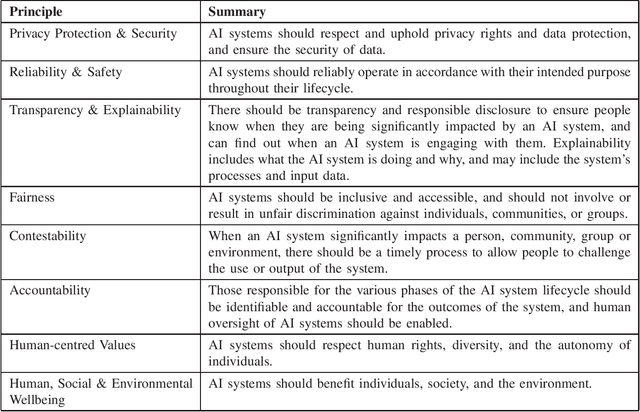David Douglas
Resolving Ethics Trade-offs in Implementing Responsible AI
Jan 16, 2024Abstract:While the operationalisation of high-level AI ethics principles into practical AI/ML systems has made progress, there is still a theory-practice gap in managing tensions between the underlying AI ethics aspects. We cover five approaches for addressing the tensions via trade-offs, ranging from rudimentary to complex. The approaches differ in the types of considered context, scope, methods for measuring contexts, and degree of justification. None of the approaches is likely to be appropriate for all organisations, systems, or applications. To address this, we propose a framework which consists of: (i) proactive identification of tensions, (ii) prioritisation and weighting of ethics aspects, (iii) justification and documentation of trade-off decisions. The proposed framework aims to facilitate the implementation of well-rounded AI/ML systems that are appropriate for potential regulatory requirements.
Implementing Responsible AI: Tensions and Trade-Offs Between Ethics Aspects
Apr 21, 2023Abstract:Many sets of ethics principles for responsible AI have been proposed to allay concerns about misuse and abuse of AI/ML systems. The underlying aspects of such sets of principles include privacy, accuracy, fairness, robustness, explainability, and transparency. However, there are potential tensions between these aspects that pose difficulties for AI/ML developers seeking to follow these principles. For example, increasing the accuracy of an AI/ML system may reduce its explainability. As part of the ongoing effort to operationalise the principles into practice, in this work we compile and discuss a catalogue of 10 notable tensions, trade-offs and other interactions between the underlying aspects. We primarily focus on two-sided interactions, drawing on support spread across a diverse literature. This catalogue can be helpful in raising awareness of the possible interactions between aspects of ethics principles, as well as facilitating well-supported judgements by the designers and developers of AI/ML systems.
AI Ethics Principles in Practice: Perspectives of Designers and Developers
Dec 14, 2021
Abstract:As consensus across the various published AI ethics principles is approached, a gap remains between high-level principles and practical techniques that can be readily adopted to design and develop responsible AI systems. We examine the practices and experiences of researchers and engineers from Australia's national scientific research agency (CSIRO), who are involved in designing and developing AI systems for a range of purposes. Semi-structured interviews were used to examine how the practices of the participants relate to and align with a set of high-level AI ethics principles that are proposed by the Australian Government. The principles comprise: Privacy Protection & Security, Reliability & Safety, Transparency & Explainability, Fairness, Contestability, Accountability, Human-centred Values, and Human, Social & Environmental Wellbeing. The insights of the researchers and engineers as well as the challenges that arose for them in the practical application of the principles are examined. Finally, a set of organisational responses are provided to support the implementation of high-level AI ethics principles into practice.
Software Engineering for Responsible AI: An Empirical Study and Operationalised Patterns
Nov 18, 2021



Abstract:Although artificial intelligence (AI) is solving real-world challenges and transforming industries, there are serious concerns about its ability to behave and make decisions in a responsible way. Many AI ethics principles and guidelines for responsible AI have been recently issued by governments, organisations, and enterprises. However, these AI ethics principles and guidelines are typically high-level and do not provide concrete guidance on how to design and develop responsible AI systems. To address this shortcoming, we first present an empirical study where we interviewed 21 scientists and engineers to understand the practitioners' perceptions on AI ethics principles and their implementation. We then propose a template that enables AI ethics principles to be operationalised in the form of concrete patterns and suggest a list of patterns using the newly created template. These patterns provide concrete, operationalised guidance that facilitate the development of responsible AI systems.
 Add to Chrome
Add to Chrome Add to Firefox
Add to Firefox Add to Edge
Add to Edge